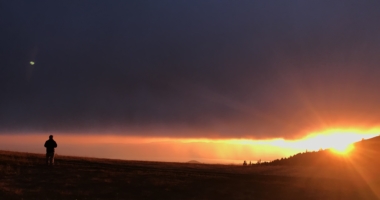GEMS Field Report: Week of 10/1/18

Montana Audubon’s annual Golden Eagle Migration Survey kicked off on September 5th 2018 with a week of sunny skies. Though fronts have passed through the site on a near weekly basis, as of October 3rd, surveyors continue to sit, snow free, atop the Big Belt mountains. During our 15 days of counting so far this season, the project has recorded 796 individuals representing 16 raptor species. Broken down, we have recorded: 338 Golden Eagles, 129 Sharp-shinned Hawks, 74 Cooper’s Hawks, 69 Red-tailed Hawks, 38 American Kestrels, 25 Northern Goshawks, 23 Bald Eagles, 18 Peregrine Falcons, 17 Northern Harriers, 12 Broad-winged Hawks, 7 Prairie Falcons, 7 Merlin, 6 Turkey Vultures, 6 Osprey, 4 Swainson’s Hawks, and 1 Ferruginous Hawk.
The remainder were 22 unknown species simply recorded to family. One unique factor our counters have noticed this year is that many birds of all species, passing through the count site appear to be very well fed. The distinctive bulge of a raptor’s full crop can be readily visible when birds fly close or are back lit by the sun. Now we are curious where those raptors’ preferred hunting grounds are. Both the Helena Valley and the many open glades in the Big Belts are sure to provide rodent fare, but it’s hard to tell by the raptor’s passing direction just where they were hunting.
The upcoming week’s weather may bring a few days of rain and a few days of partly cloudy skies. If the prevailing south-westerly winds continue, it should be a good week for migrating raptors. The pulses of cool, damp weather will likely get some birds moving, and the bit of snow that may be expected in the Big Belts, will hopefully melt during the warm days. The numbers of Golden Eagles are likely to increase, as they have steadily been doing since September 13th. We have yet to have our first Rough-legged Hawk fly by, but as that is a harbinger of winter for many, we are happy to wait.
You can follow the progress of daily counts by visiting Dunkadoo here. Visit Montana Audubon’s GEMS page here.